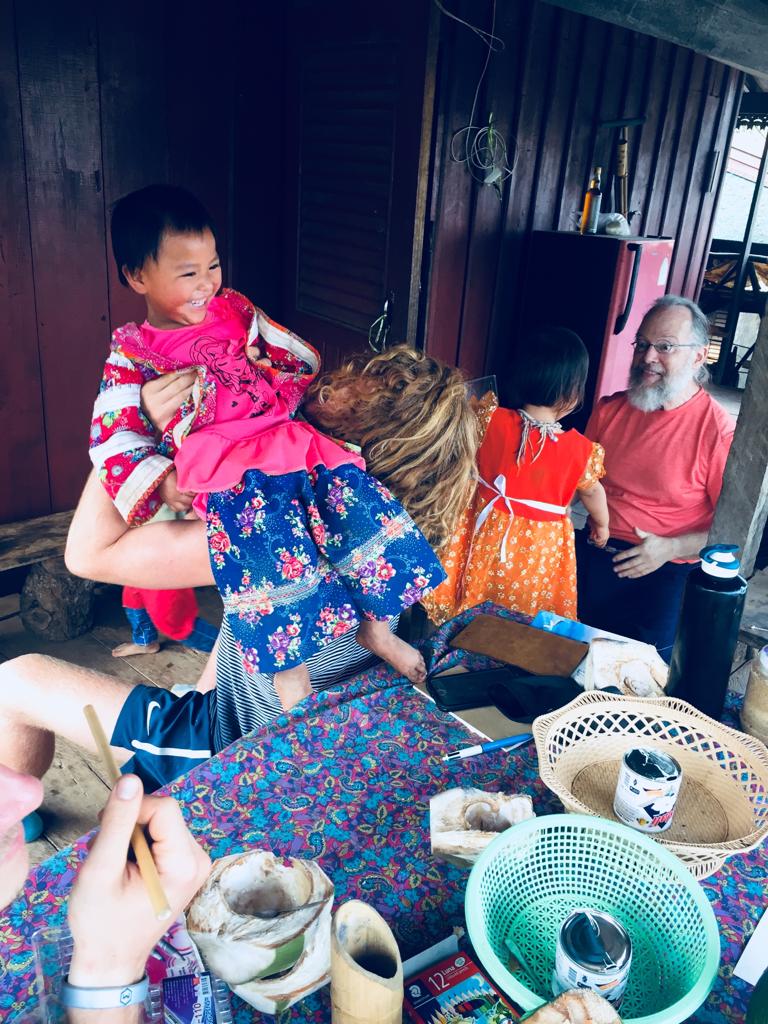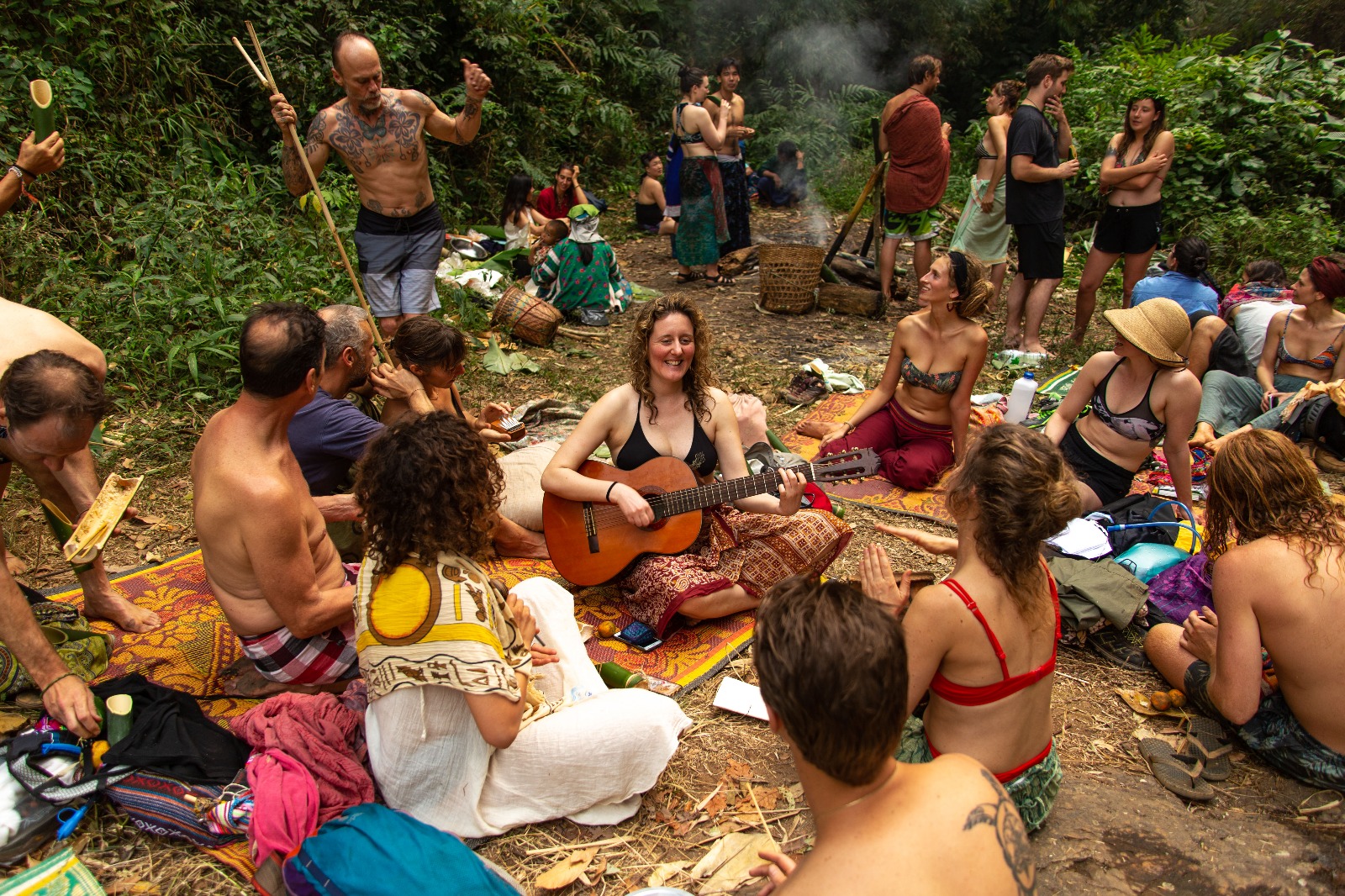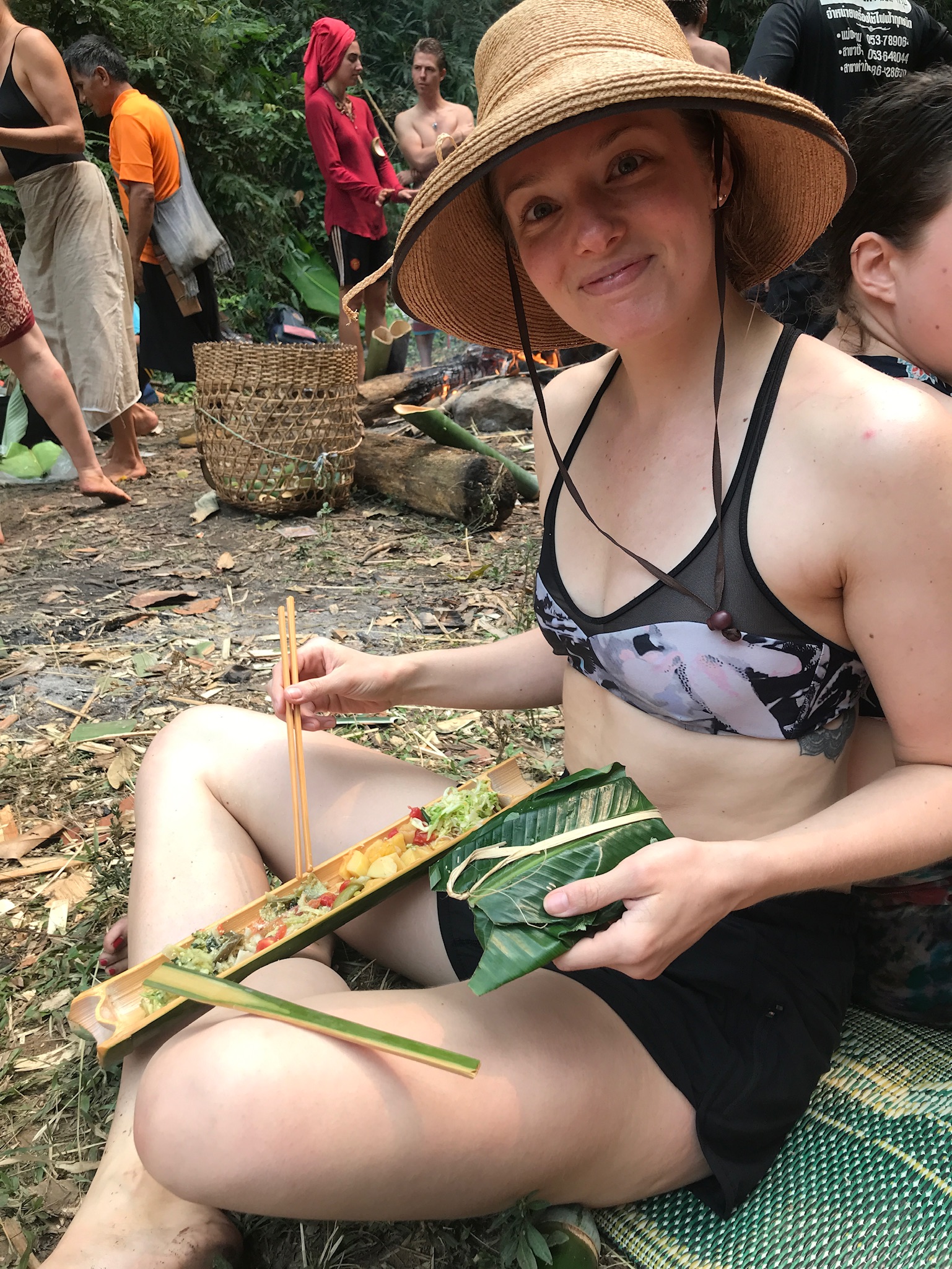With the intention to release control and let things unfold as they should, I found myself on International Women’s Day with a true sister, Vanessa Dunleavy, as my travel buddy. We hardly knew each other going into this intense 2.5 week study/work/leisure trip, but our first 17 hours in Chiang Mai together involved easy and deep conversation, open laughter, and an urgent desire to seek out 2 pounds of ground coffee to prepare for our 2 weeks of thai massage training in a remote hill tribe village of Northern Thailand. Before we embarked on our trek up the mountain, we got our legs moving around the bustling markets of Chiang Mai, where we scoped out several possible locations for our photoshoot, including the Clay Cafe, Verde Cafe, Nong Buak Park, Chiang Mai Holistic and the lovely RarinJinda Wellness Resort.
Our first full day in the Lahu Village, where we set up our new home in a primitive but well-built bamboo hut raised upon stilts that hovered over a pig and chicken pen. These beloved animals would eventually become our friends, despite rough beginnings with their sunrise symphonies around 4am of snorts, crows and sneezes (yes, a pig sneeze might be the most hilarious and adorable sound) directly beneath our tattered blanket beds on the floor.
Waking up early became part of our routine, starting with steep climb, coffee in hand, in the twilight with headlamps and glowing eyes from our wild canine friends to light the way to the platform for a 5:45am vipassana meditation. After 45 minutes of silence, we were treated with the soft glow of majestic orange painted skies over distant mountains. Following, we were guided in a 90 minute Dharma Mittra-inspired yoga class led by our beloved tattooed Lucky Love of Nashville.
As a group of about 15, we charged down the hill with growling bellies and were met by the sounds of local Thai radio pop accompanied by Lahu children unabashedly singing along at the top of their lungs and a cacophony of birds on our way to the food platform. A sweet orange cat made his home in my lap while I ate sticky rice, passionfruit and papaya while drinking more coffee with coconut milk from the entrepreneurial locals who sold essentials to the foreign visitors. We discovered only in the last couple days in the village, that toilet paper had been for sale all along, well after we had run out of our own supply and decidedly embraced the rudimentary hose that sprayed water to cleanse after squatting low over the toilets for two weeks. I actually kind of miss that experience. You can be nowhere but completely present when you’re in a thai bathroom.
I picked up a couple Lahu phrases while interacting with local Lahus and our delightful and attentive guide, co-teacher and friend, Santi, one of the adopted sons of our teacher. Half German and half Lahu, his smile is pure love and his eyes know wisdom beyond the depths of the ocean. Being one of his worldly homes, Santi made us feel at ease in the village and encouraged us to live the Lahu way. After a while, we began to wear their clothing, dance their ceremonial dances and speak a few words in their tongue. I realized later, when I tried speaking Lahu to a Thai shop owner in Chiang Mai, that tribal languages are not known outside of their villages.
Here’s some fun, casual phrases spelled phonetically:
A-ma-tee-nay? What’s up?
Dee-chi-ma-tee Nothing much
Da-day Beautiful
May-day Delicious
A-ma-cha-lo! Let’s eat!
Some of my favourite memories with the Lahus are centred around hanging out, after a big thai lunch of curry and rice loaded with vegetables, drinking locally grown coffee and drinking from coconuts hacked open by either Nana (the wife of the village Chief, Prasang) or Sombat (the village businessman who figured out how to make a lot of money by selling all-inclusive indulgent dinners of roasted pig, potatoes, broccoli and plenty of beer and even Thai whisky to us foreigners for a great bargain of 60THB per person). We would hang out in their shops, built above or beside their homes, with a view overlooking the northern Thai hills, swapping stories and vices (coffee, chocolate and tobacco) and attempting to speak each others’ languages being from all over the globe.
Lahus would find us in the evenings on our massage platform after dinner during Bhajan (devotional chanting with musical instruments) or open practice time. One of our village friends was so enthusiastic about the energy we created in our circle was smiling and clapping and wildly telling stories about snakes and salamanders and the only way to get him to quiet down and enjoy the music was to massage him with many hands.
A couple times, at sunset, there would be a Lahu ceremony in the dancing circle. This would happen often spontaneously when a family would decide they wanted to commune with the spirit world, or planned when there was a birth or death. We ate the red dust as we attempted to participate in the tribe-specific dance steps. The men stomped around the outer circle and I held hands with some of my Thai student friends and Lahu women, stumbling through the seemingly simple shuffle steps, forward and backward to the rhythmic melody of the flute-type instrument with keys that sounds like a muted bagpipe.
Lahu ceremony in the Dancing Circle, picturing the traditional flute-like instrument to which the dances were set. Also featuring traditional Lahu clothing, which many of us foreigners started wearing by the end of our stay.
One of the Lahus, well versed in English thanks to the frequent German travelers who taught him over a few months in exchange for knowledge of plant medicine, thanked me with such heart after the ceremony was over and invited me to join him in the hut of the Village’s medicine man. This 80-something-year-old man, sitting cross-legged by a fire sipping tea (which healed my canker sores upon waking the next day), was his teacher. Here I learned that La-Hu means Tiger Hunter in their tongue and the medicine man had killed many in the jungle with bow and arrow in his time.
There are about four tribes in the northern region of Thailand, all speaking different languages and specializing in different trades - the Lahu’s being sewing and textiles - and they grow everything they consume except for salt and oil and the occasional ice cream bar imported from the cities for the children. It’s quite odd to see some children with mobile phones and satellites on their bamboo huts as a strange juxtaposition between their simple lifestyle and the slow infusion of Western comforts into their lifestyle. I asked my new friend what the most important thing was in the Lahu culture and his answer was “sharing”. And that’s what they did for us foreigners: shared their hearts, meals, homes, songs, traditions and more, including their secret waterfall picnic spots where we had a full on gypsy fest complete with music, bamboo brewed coffee, waterfall jumping and lazy musical serenades.
And I wonder how I could have ever returned home?













